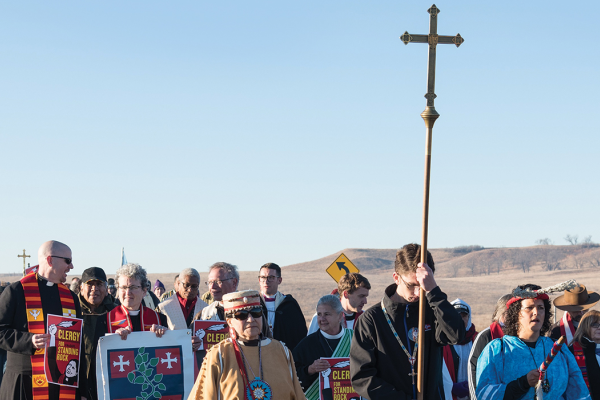THE STANDING ROCK Sioux Nation has actively opposed the construction of an oil pipeline intended to cross the Missouri River adjacent to their land since learning of the planned route in 2014. Joined first by Native American tribes from across the country, and more recently by others including military veterans and clergy, the “water protectors” scored a major victory in December when the U.S. Army Corps of Engineers denied permits for the construction of the river crossing and, as we went to press, began examining the environmental impact of alternative routes. —The Editors
A thin layer of smoke from dozens of campfires hung low in the air over the Oceti Sakowin camp the morning of Nov. 3. More than 500 faith leaders had assembled at the camp’s sacred fire in solidarity with water protectors who have held vigil on the shores of North Dakota’s Cannonball River since April.
Rev. John Floberg, supervising priest of the Episcopal churches on the North Dakota side of Standing Rock, led the gathered clergy encircling the camp’s perpetual sacred fire in a ceremony of apology and repudiation of the Doctrine of Discovery, the papal edict issued in 1493 granting Western colonizers the right of dominion over Indigenous peoples and lands.
Leaders from faith groups that officially have repudiated the Doctrine of Discovery—including Baptist, Episcopal, Lutheran, and Presbyterian—joined Floberg in the speakers’ area facing tribal elders, where they each read a portion of an adapted repudiation statement crafted by the World Council of Churches. Following the apology, copies of the Doctrine of Discovery were offered to the elders who were asked if they wanted to place the documents in the sacred fire. After conferring, one elder said, “This paper, these words, do not belong in a sacred fire.” They chose instead to burn the documents in vessels placed between faith leaders and tribal elders.
Members of the Standing Rock Sioux Nation and thousands of supporters assembled here to oppose the Dakota Access pipeline, the 1,172-mile pipeline that was scheduled to run under Lake Oahe on the Missouri River just north of tribal lands. Dallas-based Energy Transfer Partners is overseeing construction of the pipeline, which is designed to transport crude oil from the Bakken oil fields to Midwestern refineries. Though the protest originally focused on the pipeline’s environmental risks, activists are also concerned about the desecration of sacred sites and the continued violation of the 1851 Treaty of Fort Laramie, which protected Indigenous lands from exploration, extraction, and development.
The solidarity gathering came together after Floberg posted a late-October Facebook call for clergy to assemble at the camp. He initially anticipated 100 people would join; he said he was overwhelmed as the number of respondents grew beyond 500.
“We are grateful to the Standing Rock Sioux Nation for their invitation for people to come and stand in solidarity with them,” said Floberg during the gathering’s introductory meeting, urging participants to conduct themselves with respect toward law enforcement and not to contribute to any acts of violence. “You are representing your faith tradition. And here, more than anything, you are representing the Standing Rock Sioux Nation. It is their reputation, their life, that will continue on long after you go.”
After the repudiation ceremony, clergy processed north from the camp to the barricaded and well-guarded bridge across the Cannonball River, with periods of song and silence. The bridge has been the site of multiple clashes between law enforcement and Native American activists. A burned-out shell of a car sat at the side of the road, and two torched trucks in the road provided a blockade across the river. Past a line of law enforcement vehicles, pipeline construction could be seen on the next set of hills.
In the unseasonably warm midday sun, faith leaders spoke words of solidarity with the people of Standing Rock, pledging support and political action.
“From the Muslim tradition, one of our most important passages is standing up for justice, even if it’s against your mother or father or against yourself,” said Sahar Alsahlani from the organization Green Faith and the interfaith Fellowship of Reconciliation. “I’m from Iraq, from the marshlands, and I’ve seen what the quest for oil and gasoline can do to an Indigenous community. I saw a replication of that happening here and definitely had to say something, because I cannot stand by and see another catastrophe happen.”
Kelly Sherman-Conroy, a Luther Seminary student and member of the Oglala Lakota nation, joined dozens of seminarians at the protest. She said her solidarity came from her upbringing, when she learned the importance of God’s creation. “We were able to integrate both our Sioux and Christian traditions together,” she said of these stewardship lessons. “My grandfather said we always need to be a voice for those who can’t speak. That’s why I’m here; to stand beside Standing Rock and to [support] the voice Indigenous people have struggled to have.”
AS THE FINAL ACT of the clergy gathering, Paul Sneve, archdeacon in the Episcopal Diocese of South Dakota and a member of the Rosebud Sioux tribe, led the clergy in a Niobrara Circle, a ceremony in which selected persons turn and greet each person in the circle. With more than 500 participants spread across both sides of the road, extending down into a ditch and up onto a hillside, the ceremony took 90 minutes.
Police have arrested more than 400 people as the result of protests. Earlier on Nov. 2, a group of water protectors attempted to cross the Cannonball River north of camp to pray on what has become known as Turtle Hill. Standing chest deep in frigid water, advocates were turned back by riot police dousing the crowd with pepper spray and shooting shotgun-propelled beanbags at others across the shore.
Vanessa [last name withheld], from the Lower Elwha Klallam Tribe in Port Angeles, Wash., received a direct hit of pepper spray to the face. She has been at Standing Rock since August “to protect Mother Earth and the water we all live off [of].”
“We’re going to do what it takes to protect this water. As they say in the camp, mni wiconi, water is life. We all need it. Our children need it. Our children’s children need it. And their children need it,” she said, pointing to officers stationed at the top of Turtle Hill.
Later in the afternoon, a group of nearly 100 clergy and other supporters traveled to Bismarck to stage a sit-in at the judicial wing of the state capitol building. Fourteen clergy were arrested there, and three others were arrested when they crossed the street to kneel on the lawn at Gov. Jack Dalrymple’s residence. Floberg, for his part, decried the actions in Bismarck because they weren’t authorized by the Standing Rock Sioux tribe.
Mike [last name withheld], a member of the Oglala Sioux tribe in Pine Ridge, S.D., who had been present at Standing Rock for two months before the November clergy gathering, said he’s willing to stay “until it’s done, until we stop that pipe.” He added that if the efforts fail to stop construction in North Dakota, he’ll go to Iowa to assist there. “We’ve got to stop it somehow. We can’t let them keep walking on us.”
Mike said the clergy gathering received the “light version” of treatment by authorities compared to that meted out to Native activists. “Because of all the clergy—if they hadn’t known you were coming, you’d have seen lines of cars and busses come down to meet you.” (In late November, police in riot gear sprayed 400 marchers with water cannons, despite freezing temperatures, and pelted the demonstrators with concussion grenades, tear gas, and rubber bullets.)
Áine O’Connor, of the Sisters of Mercy in Baltimore, was one of many Catholics who joined the clergy gathering. “A very important part of coming here and following the concerns at Standing Rock over these months,” O’Connor said, “is to make very clear to the American people and those worldwide [about] the inhumane militarized response to what’s happened in relation to what’s going on here—peaceful protest, peaceful protection—people being described as rioters and criminalized.”
“It’s an opportunity to give voice, to literally practice our democracy,” O’Conner added. “To say what is going on, the rights are being violated and the earth is speaking to us, saying we can’t be silent; we need to tell what’s happening.”
The early December decision by the Corps of Engineers to deny an easement for the pipeline route across Lake Oahe—days before another pipeline in the area spilled 176,000 gallons of crude oil into a creek—is a sign that the voices gathered at Standing Rock have indeed been heard. All indications are that the chorus is just warming up.

Got something to say about what you're reading? We value your feedback!

